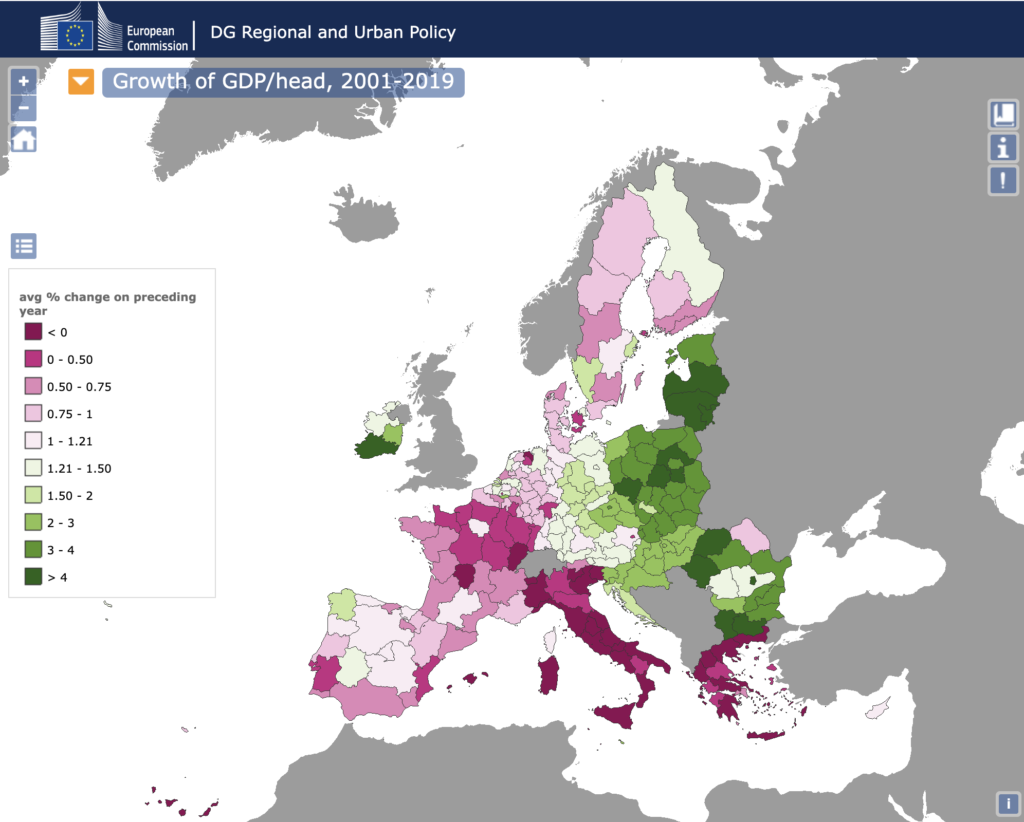L’ottava relazione sulla coesione, pubblicata dalla Commissione europea, presenta i principali cambiamenti nelle disparità territoriali nell’UE nell’ultimo decennio e il modo in cui le politiche dell’UE e nazionali hanno influito su tali disparità.
Attraverso la mappa interattiva digitale della Relazione, che evidenzia l’importanza dei dati georeferenziati sempre sottolineata dal progetto DYDAS (cofinanziato dal programma Connecting Europe Facility), è possibile esplorare una selezione di mappe e dati interattivi sulle tendenze demografiche regionali.
La relazione mostra come la riduzione della popolazione colpisca sempre più regioni dell’UE. Il principale motore della riduzione della popolazione è il crescente cambiamento naturale negativo nell’UE. E tale cambiamento non sarà compensato dalla migrazione.
L’attuale struttura dell’età della popolazione, l’aumento dell’aspettativa di vita e i tassi di fertilità relativamente bassi nell’UE indicano che praticamente tutte le regioni subiranno un forte aumento della popolazione di 65 anni e oltre e una riduzione della popolazione giovane e in età lavorativa. Le regioni dovranno adattare i loro servizi e le loro infrastrutture a questi cambiamenti nella popolazione totale e nella loro distribuzione per età. Inoltre, le imprese dovranno adeguarsi a una contrazione della popolazione in età lavorativa investendo maggiormente nell’aumento della manodopera e nelle tecnologie per il risparmio di manodopera.
Durante gli anni 2010, la popolazione dell’UE è cresciuta dell’1,9 per 1000 abitanti all’anno. Il tasso di crescita della popolazione più elevato si è registrato nell’UE nordoccidentale (4 per 1000 abitanti all’anno). La crescita della popolazione nell’UE meridionale è stata inferiore (1 per 1000), mentre la popolazione nell’UE orientale è diminuita (-2 per 1000). La riduzione della popolazione nell’UE orientale ha fatto sì che due persone su tre vivessero in una regione che ha perso popolazione nell’ultimo decennio. Questo è stato il caso di una persona su tre nell’UE meridionale e solo di una persona su cinque nell’UE nordoccidentale.
Le proiezioni indicano che entro il 2040 metà della popolazione dell’UE vivrà in una regione in diminuzione. Ciò interesserà le regioni orientali più di quelle nordoccidentali. Le proiezioni suggeriscono che nel 2040 l’85% della popolazione delle regioni orientali vivrà in una regione in calo rispetto al 37% nelle regioni nord-occidentali.
#EURegioDataStories – #CohesionReport – #CohesionForum

Journey on regional demographic trends in the EU through data.
The 8th Cohesion Report published by the European Commission, presents the main changes in territorial disparities in the EU over the last decade and how EU and national policies have affected these disparities.
Through the digital interactive map of the Report, which highlights the importance of georeferenced data always underlined by the DYDAS project (co-funded by the Connecting Europe Facility programme), it is possible to explore a selection of maps and interactive data on regional demographic trends.
The report shows that population reduction is affecting more and more regions of the EU. The main driver of population decline is growing negative natural change in the EU. And that change will not be offset by migration.
The current age structure of the population, rising life expectancy and relatively low fertility rates in the EU mean that virtually all regions will experience a sharp increase in the population aged 65 and over and a reduction in the young population and of working age. Regions will have to adapt their services and infrastructure to these changes in the total population and their age distribution. In addition, businesses will have to adjust to a shrinking working-age population by investing more in labor augmentation and labour-saving technologies.
During the 2010s, the EU’s population grew by 1.9 per 1000 inhabitants per year. The highest population growth rate was recorded in the north-western EU (4 per 1000 inhabitants per year). Population growth in the southern EU was lower (1 per 1000), while the population in the eastern EU decreased (-2 per 1000). Population reduction in the eastern EU has meant that two out of three people live in a region that has lost population over the last decade. This was the case for one in three people in the southern EU and only one in five people in the north-western EU.
Projections indicate that by 2040, half of the EU’s population will be living in a shrinking region. This will affect the eastern regions more than the northwestern ones. Projections suggest that in 2040, 85% of the population of the eastern regions will live in a declining region compared to 37% in the northwestern regions.


